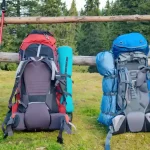

Are you ready to embark on an exciting wild camping adventure? As a seasoned camper and outdoor enthusiast with decades of experience exploring the wilderness, I can tell you that having the right gear is essential for a successful trip. After all, nothing spoils a camping trip faster than being unprepared and uncomfortable in the great outdoors. But fear not, fellow campers! In this comprehensive checklist, I’ll share with you the essential gear you need to pack for your next wild camping adventure, so let’s get started!
Shelter: The Foundation of a Good Night’s Sleep
A sturdy and reliable tent is the cornerstone of your camping setup. Look for a tent that is lightweight, easy to set up, and durable enough to withstand the rigors of the wilderness. There are several types of tents to choose from, including dome tents, tunnel tents, and geodesic tents.
- Dome tents are the most common and offer a good balance between weight, space, and ease of setup. They are freestanding, meaning they can stand on their own without the need for stakes, making them ideal for camping on rocky terrain. Look for a dome tent with a waterproof rainfly to keep you dry during those unexpected downpours.
- Tunnel tents are designed with a long, tunnel-like shape and are excellent for camping in windy conditions. They provide ample living space and are more aerodynamic, making them a great option for campers who prioritize stability in harsh weather conditions.
- Geodesic tents are the sturdiest and most stable tents available, thanks to their complex pole structure. They are designed to withstand extreme weather conditions, making them perfect for mountaineering or camping in alpine environments. However, they are also heavier and more complicated to set up, so they may not be the best option for beginner campers.
Pro Tip: Always set up your tent before you go camping to make sure you know how to pitch it correctly and that all the components are in good condition.
Recommended Tent: Big Agnes Copper Spur HV UL2
Cozy Sleeps: Stay Warm and Comfortable All Night Long
A good night’s sleep is crucial for an enjoyable camping experience, and that starts with a high-quality sleeping bag. Look for a sleeping bag that is rated for the lowest temperature you expect to encounter during your camping trip. Keep in mind that temperatures can drop significantly at night, even during the summer months, so it’s better to be prepared for the cold.
Sleeping bags come in a range of shapes, sizes, and materials, so it’s important to choose one that fits your needs and preferences. Mummy bags are tapered at the feet and provide a snug fit, which helps to retain heat and minimize drafts. They are great for camping in cold weather but may feel constrictive to some campers. Rectangular bags are more spacious and offer more room to move around, making them ideal for warmer weather or for campers who prefer a more relaxed fit.
When it comes to materials, down-filled sleeping bags are lightweight and highly compressible, making them ideal for backpacking trips. They also provide excellent insulation and are incredibly warm. On the other hand, synthetic-filled sleeping bags are more affordable, retain their insulation properties even when wet, and are hypoallergenic, making them a good option for campers with allergies.
Pro Tip: To keep your sleeping bag clean and odor-free, air it out during the day and store it in a dry and clean environment when not in use. Avoid storing it compressed for long periods of time, as it can decrease its insulation properties.
Recommended Sleeping Bag: Nemo Disco 15 Degree Sleeping Bag
Restful Nights: Don’t Forget a Quality Sleeping Pad
A sleeping pad is just as important as a sleeping bag for a good night’s sleep while camping. It not only provides cushioning and comfort but also acts as insulation between you and the cold ground. There are three main types of sleeping pads to consider: foam pads, self-inflating pads, and inflatable pads.
- Foam pads are the most affordable and durable option. They are made from closed-cell foam and are lightweight and easy to pack. However, they can be bulky and not as comfortable as other options.
- Self-inflating pads are made from a combination of foam and air, and they provide a good balance between comfort and insulation. They are easy to inflate and deflate, making them a popular choice among campers. However, they can be heavier and bulkier compared to other options.
- Inflatable pads are the most comfortable and compact option. They are made from lightweight materials and can be easily inflated using a pump or your breath. They provide excellent insulation and cushioning, but they can be more expensive and delicate.
Pro Tip: Always test your sleeping pad at home before heading out to make sure it’s inflated properly and there are no leaks or punctures.
Recommended Sleeping Pad: Therm-a-Rest NeoAir Xlite Ultralight Backpacking Air Mattress
Fire Up: Essential Tools for Campfire Cooking
One of the joys of camping is cooking over an open flame, but it requires some essential tools to do it right. Here are some must-have items for campfire cooking:
- Camp stove: A reliable camp stove is essential for cooking meals and boiling water. Look for a lightweight and compact camp stove that is easy to set up and has good fuel efficiency. Some stoves use propane canisters, while others use liquid fuel. Choose the one that suits your camping style and location.
- Cooking utensils: Pack a set of camping-specific cooking utensils, such as a spatula, tongs, and a pot lifter. These utensils are designed to be lightweight and durable, making them ideal for outdoor cooking.
- Cooking pots and pans: Invest in a good quality camping cookware set that includes pots and pans with lids. Look for cookware made from lightweight materials, such as aluminum or titanium, as they are durable and heat up quickly.
- Cooler: If you plan to bring perishable food items, a cooler is a must-have item to keep your food fresh and safe. Look for a cooler with good insulation and a tight seal to prevent any leakage.
Pro Tip: Plan your meals ahead of time and prep ingredients at home to make cooking at the campsite easier and more enjoyable.
Recommended Camp Stove: MSR PocketRocket 2 Ultralight Backpacking, Camping, and Travel Stove
Recommended Camping Cookware Set: GSI Outdoors Bugaboo Base Camper
Light Up the Night: Illuminate Your Campsite
Having reliable lighting is essential for camping, especially during the dark evenings and early mornings. Here are some must-have lighting gear for your wild camping adventure:
- Headlamp: A good quality headlamp is a must-have item for hands-free illuminationof your campsite. Look for a headlamp with adjustable brightness levels, a long battery life, and a comfortable fit. It’s also worth considering a headlamp with a red light mode, which can help preserve your night vision.
- Lantern: A lantern is a great addition to your camping gear, as it provides ambient light for your campsite. Look for a lantern with a hook or a handle for easy hanging, and one that is lightweight and durable. Some lanterns also come with additional features like a USB charging port or a built-in power bank, which can be handy for charging your devices.
- Flashlight: A reliable flashlight is a must-have for any camping trip. Look for a flashlight with a long beam distance and a durable construction. Consider a waterproof or shockproof flashlight for added durability in outdoor conditions.
- Campfire starter: While campfires are a great source of warmth and ambiance, starting a fire can sometimes be challenging. Pack some reliable campfire starters, such as waterproof matches, a fire starter kit, or a fire starter log, to ensure you can easily light up your campfire.
- Pro Tip: Always carry spare batteries for your headlamp, lantern, and flashlight to avoid running out of power during your camping trip.
- Recommended Headlamp: Black Diamond Storm Headlamp
- Recommended Lantern: Coleman LED Lantern
- Recommended Flashlight: ThruNite TN12 V4 LED Flashlight
- Recommended Campfire Starter: UCO Stormproof Match Kit with Waterproof Case
Stay Hydrated: Water Filtration and Storage
Access to clean drinking water is crucial for any camping trip. Here are some essential gear for water filtration and storage:
- Water filter: A reliable water filter is a must-have for camping in the wilderness. Look for a water filter that is lightweight, portable, and easy to use. There are various types of water filters available, such as pump filters, gravity filters, and straw filters. Choose the one that suits your camping style and water source.
- Water bottles: Pack enough water bottles to stay hydrated during your camping trip. Look for durable water bottles made from BPA-free materials and with a good sealing system to prevent leaks. Consider collapsible water bottles to save space in your backpack when empty.
- Water storage container: If you’re camping in an area where water sources are scarce, consider bringing a water storage container to store and transport water. Look for a container that is durable, easy to carry, and has a tight seal to prevent spillage.
Pro Tip: Always check the water quality and regulations of the area you’re camping in and follow proper Leave No Trace principles for water use and disposal.
Recommended Water Filter: Sawyer Products Squeeze Water Filtration System
Recommended Water Bottle: Nalgene Tritan Wide Mouth Water Bottle
Recommended Water Storage Container: Reliance Products Aqua-Tainer Water Container
Keep Yourself Fed: Essential Food and Cooking Supplies
Proper nutrition is crucial for energy and endurance during your wild camping adventure. Here are some essential food and cooking supplies to pack:
- Food: Plan your meals ahead of time and pack non-perishable food items that are easy to prepare and store. Consider lightweight and compact options such as freeze-dried meals, energy bars, trail mix, and canned goods. Don’t forget to pack enough food to last for the duration of your camping trip, taking into account any extra days or unexpected delays.
- Cooking stove: A reliable camping stove is essential for cooking your meals in the wilderness. Look for a portable and lightweight camping stove that is easy to set up and use. There are various types of camping stoves available, such as propane stoves, butane stoves, and alcohol stoves. Choose the one that fits your camping style and cooking needs.
- Cookware: Pack a durable and lightweight cookware set that includes a pot, a pan, and cooking utensils. Look for cookware made from materials such as stainless steel or titanium, as they are lightweight and durable. Consider collapsible or nesting cookware to save space in your backpack.
- Fire starter: In addition to campfire starters, it’s a good idea to pack a reliable fire starter for cooking purposes. Options include matches, a fire starter kit, or a fire starter log. Make sure to store them in a waterproof container to keep them dry.
Pro Tip: Practice Leave No Trace principles when cooking in the wilderness, and be mindful of fire regulations and restrictions in the area you’re camping in.
- Recommended Food: Mountain House Classic Bucket of Freeze-Dried Food
- Recommended Camping Stove: Jetboil Flash Camping and Backpacking Stove
- Recommended Cookware Set: GSI Outdoors Bugaboo Base Camper Cookware Set
- Recommended Fire Starter: Light My Fire Swedish FireSteel 2.0
Author

Tom Miller
Tom is a seasoned camper and outdoor adventurer, with decades of experience exploring the wilderness. He's a retired park warden and has spent his life studying the flora and fauna of the natural world. Tom is a skilled outdoorsman, with a particular interest in backcountry camping, mountaineering, and wilderness survival. He's also an accomplished writer and has published several books on outdoor recreation.
Recent Posts


